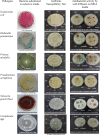Antibacterial Activity of Selected Fruit Juices against Multidrug-Resistant Bacterial Pathogens Involved in Urinary Tract and Sexually Transmitted Infections among Tribal Women in Madhya Pradesh, India
- PMID: 37799616
- PMCID: PMC10547819
- DOI: 10.3831/KPI.2023.26.3.265
Antibacterial Activity of Selected Fruit Juices against Multidrug-Resistant Bacterial Pathogens Involved in Urinary Tract and Sexually Transmitted Infections among Tribal Women in Madhya Pradesh, India
Abstract
Objectives: The aim of this study was to evaluate the effect of fruit juices on Multi-Drug Resistant (MDR) bacterial pathogens involved in Urinary Tract Infections (UTIs) and Sexually Transmitted Infections (STIs) among tribal women in the district Anuppur, Madhya Pradesh, India.
Methods: Fresh juices of lemon (Citrus limon), amla/Indian gooseberry (Phyllanthus emblica), pineapple (Ananas comosus), mosambi/sweet lime (Citrus limetta), orange (Citrus sinensis), kiwi (Actinidia deliciosa), and pomegranate (Punica granatum) fruits were evaluated for in vitro antibacterial activity against bacterial pathogens involved in UITs and STIs among tribal women. Physico-chemical analysis of fresh fruits was also carried out by measuring the pH, moisture, protein, fat, crude fibre, carbohydrate, and ascorbic acid content.
Results: Lemon and amla juice showed better antibacterial activity against the pathogens as compared to other juices. MIC results fruit juices against UTIs and STIs pathogens vary depending on the specific pathogen and juice chemical constituents. The physico-chemical analysis showed that the moisture content was highest in mosambi (90%), followed by orange (87%). Ascorbic acid content was found highest in amla (540 mg/100 g), followed by kiwi (90.3 mg/100 g). Pomegranate showed highest concentration of carbohydrate (15.28 g/100 g), fat (1.28 g/100 g), and protein (1.65 g/100 g). Lemon juice had lowest pH of 2.20, followed by amla 2.67.
Conclusion: The lemon juice showed highest antibacterial activity against MDR bacterial pathogens involved in UTIs and STIs among tribal women in district Anuppur, Madhya Pradesh, India. The low pH of lemon may be responsible for its high antibacterial activity as compared to other juices.
Keywords: antibacterial activity; fruit juices; multi-drug resistant; sexually transmitted infection; uropathogens.
© 2023 Korean Pharmacopuncture Institute.
Conflict of interest statement
CONFLICTS OF INTEREST The authors declare that there is no conflict of interest.
Figures



Similar articles
-
Role of Citrus Fruit Juices in Prevention of Kidney Stone Disease (KSD): A Narrative Review.Nutrients. 2021 Nov 17;13(11):4117. doi: 10.3390/nu13114117. Nutrients. 2021. PMID: 34836376 Free PMC article. Review.
-
Cloud stabilization of citrus fruit juices treated with purified pectin methylesterase inhibitor from lemon (Citrus limon L.).J Sci Food Agric. 2022 Oct;102(13):6156-6162. doi: 10.1002/jsfa.11969. Epub 2022 May 20. J Sci Food Agric. 2022. PMID: 35477867
-
The effects of fruit juices and fruits on the absorption of iron from a rice meal.Br J Nutr. 1987 May;57(3):331-43. doi: 10.1079/bjn19870041. Br J Nutr. 1987. PMID: 3593665
-
Survival of Lactobacillus plantarum in model solutions and fruit juices.Int J Food Microbiol. 2011 Mar 30;146(2):111-7. doi: 10.1016/j.ijfoodmicro.2011.01.040. Epub 2011 Mar 14. Int J Food Microbiol. 2011. PMID: 21411170
-
Food-drug interactions precipitated by fruit juices other than grapefruit juice: An update review.J Food Drug Anal. 2018 Apr;26(2S):S61-S71. doi: 10.1016/j.jfda.2018.01.009. Epub 2018 Feb 15. J Food Drug Anal. 2018. PMID: 29703387 Free PMC article. Review.
References
-
- Sarkar S, Patra AC, Srinivas P, Ghosh A, Kushbaha G, Saha S. Pattern of sexually transmitted infections: a profile from a rural- and tribal-based sexually transmitted infections clinic of a tertiary care hospital of Eastern India. J Family Med Prim Care. 2018;7(5):1042–6. doi: 10.4103/jfmpc.jfmpc_80_17. - DOI - PMC - PubMed
LinkOut - more resources
Full Text Sources
Research Materials
